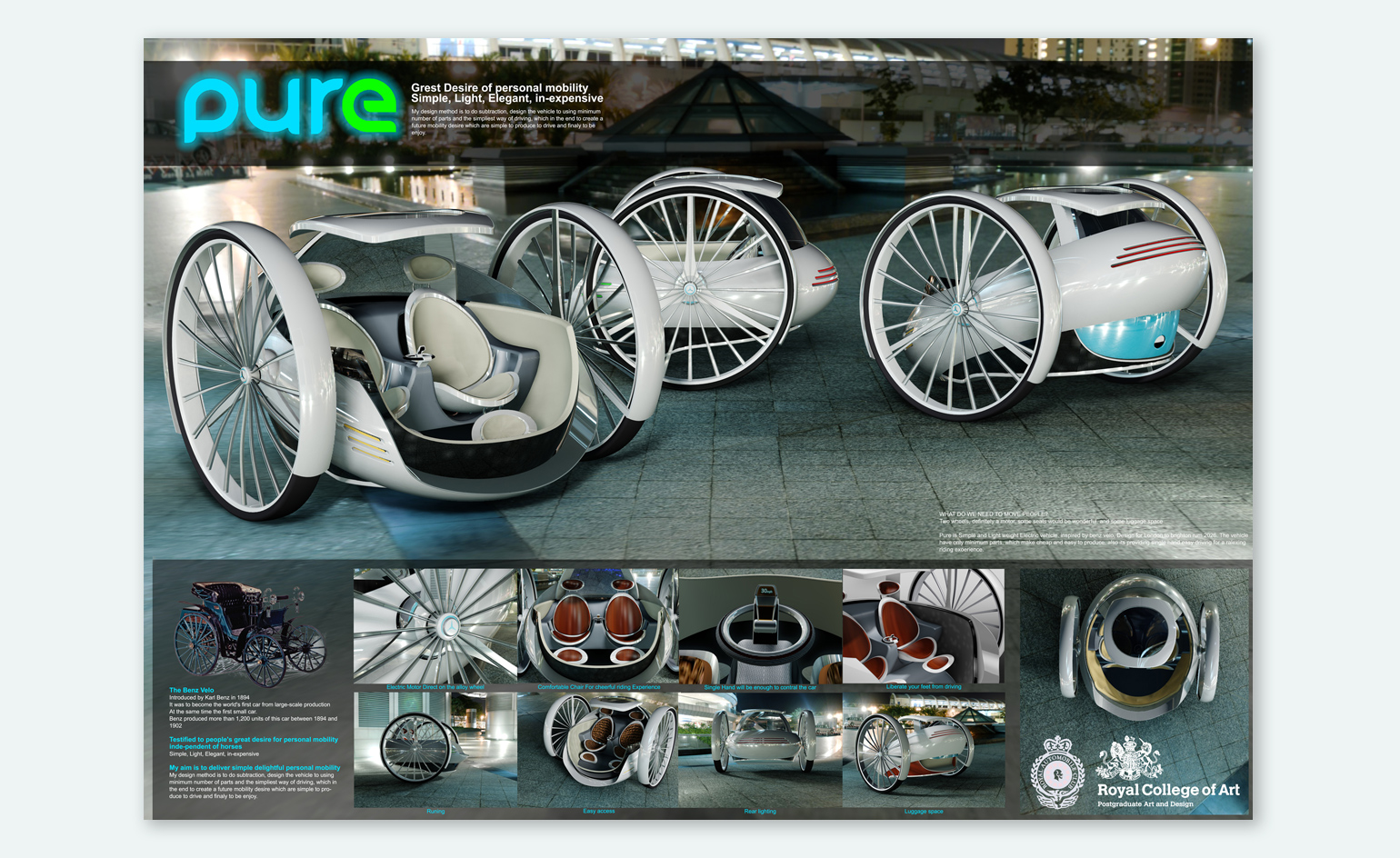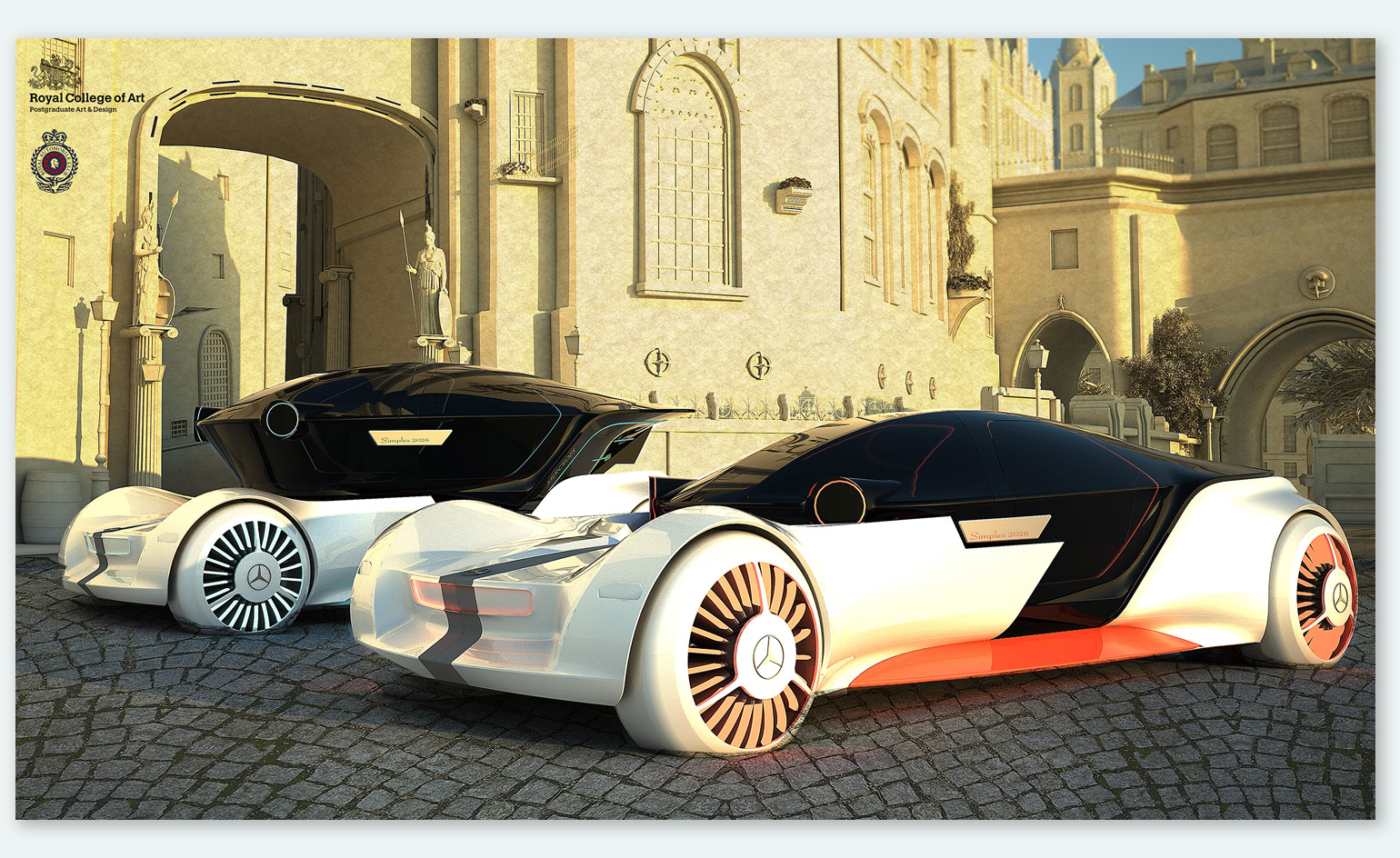The next generation of auto designers imagine cars for tomorrow’s world

Car design has, for some 100 years, managed to steer clear of any major technological upheavals. The vast majority of cars we drive today are still based on blueprints developed by Karl Benz and Gottlieb Daimler in 1886 – the Benz Patent Motor Car – alongside other iconic cars of the early 20th century such as the Model T Ford. They mostly have four wheels, front-facing seats and an engine powered by a liquid, formed over millennia and lifted from the earth’s crust.
But disruption is becoming more commonplace in the automotive industry. ‘We [will] see more change in the next five years than there’s been in the last 50,’ said Dan Ammann, president of General Motors earlier this year. Advances in technology enable the development of driverless and connected cars, powered by electricity and hydrogen fuel cells. These developments have the ability to radically adjust the way we perceive, interact, travel and consume cars, particularly in an urban setting.
The next generation of auto designers must engineer cars that embrace these technologies and tap into new consumer trends while capitalising on decades of brand legacy and customer loyalty. For students of the Royal College of Art (RCA) Vehicle Design faculty taking part in this year’s Royal Automobile Club design competition, the task was designing a sustainable, connected and potentially driverless vehicle for an imagined Brighton to London rally in 2026.

Po-Wei Lee's entry
Building on the heritage of European brands such as Mercedes, Peugeot and Darracq, the concepts built on the aesthetics and characteristics of a typical early 20th-century car on the run. With four weeks to complete the project, 12 students were shortlisted to attend the final round, held in the palatial surroundings of the Royal Automobile Club in Pall Mall, London.
Overall competition winner Yang Lui’s 'Benz Velo' is inspired by the 1894 car with which it shares its name. As with one of the first small cars, Liu’s concept is intended to be simple, lightweight and inexpensive, using few components to form a solution for commuters in an urban environment. With two electric motors in each wheel, the car is capable of rotating on its axis with movement controlled by a central joystick.
Bin Sun’s 'Mercedes Simplex' concept is based on the 1902 car of the same name. Sun’s design captures the Simplex’s sporting credentials in its shape as a driver’s car for 2026, with driving pleasure and luxury a focus. ‘Traditionally, people have always looked to the front of the car but in this concept, it’s a different experience for the passengers, experiencing luxury and views out of the rear instead,’ says Sun.
Stavros Mavrakis’ 'Vis-à-vis' concept is based on the Peugeot Type 9 Vis-à-Vis from 1895. The face-to-face configuration encourages interaction with fellow passengers and, with the exposed cockpit, encapsulates the thrill of open touring.

Zi Lin's take on a 1902 Darracq Tonneau
De Dion-Bouton, one of the largest engine manufacturers of the early 20th century, supplied automakers all over the world. Jack Watson’s 2026 ‘Type H’ is a contemporary take on De Dion-Bouton engineering, powered by hydrogen fuel-cell technology, which is contained within a platform, located underneath the cabin. ‘Because it’s a saloon car, by definition, the cabin is separate from the storage compartment and rest of the vehicle, so there’s a clear separation in the different compartments of the vehicle,’ says Watson.
Zi Lin’s 'Darracq for 2026' takes its inspiration from the Darracq Tonneau of 1902. Designed for users aged between 25–35 years, the car’s layout can be shifted from a four-seater compact to a two-seater Kei-car by folding or adjusting the backseat and the roof.
Eunji Choi’s design is a reimagined 2026 iteration of the Benz Velo from the late 19th century. Choi’s concept offers a premium short-distance car sharing system within urban environments with a focus on privacy through the enclosed cockpit.

Chan Park Sik's riff on a Mercedes Simplex was highly commended at the design competition

Jack Watson’s 2026 ‘Type H’ is a contemporary take on De Dion-Bouton engineering, powered by hydrogen fuel-cell technology

Bin Sun’s 'Mercedes Simplex' concept captures the model's sporting credentials in its shape as a driver’s car for 2026, with driving pleasure and luxury a focus

Stavros Mavrakis’ concept is based on the Peugeot Type 9 Vis-à-Vis from 1895
For more information, visit the RCA website
Wallpaper* Newsletter
Receive our daily digest of inspiration, escapism and design stories from around the world direct to your inbox.
-
 The Subaru Forester is the definition of unpretentious automotive design
The Subaru Forester is the definition of unpretentious automotive designIt’s not exactly king of the crossovers, but the Subaru Forester e-Boxer is reliable, practical and great for keeping a low profile
By Jonathan Bell
-
 Sotheby’s is auctioning a rare Frank Lloyd Wright lamp – and it could fetch $5 million
Sotheby’s is auctioning a rare Frank Lloyd Wright lamp – and it could fetch $5 millionThe architect's ‘Double-Pedestal’ lamp, which was designed for the Dana House in 1903, is hitting the auction block 13 May at Sotheby's.
By Anna Solomon
-
 Naoto Fukasawa sparks children’s imaginations with play sculptures
Naoto Fukasawa sparks children’s imaginations with play sculpturesThe Japanese designer creates an intuitive series of bold play sculptures, designed to spark children’s desire to play without thinking
By Danielle Demetriou
-
 Peugeot’s sparky 308 gets hybrid power and handsome lines
Peugeot’s sparky 308 gets hybrid power and handsome linesThe Peugeot 308 proves that mass-market design needn’t be dull, blending hybrid power with sharp lines and excellent detailing
By Jonathan Bell
-
 BMW Motorrad brings out the big guns for its newest cruisers
BMW Motorrad brings out the big guns for its newest cruisersBMW Motorrad R 18 Bagger and Transcontinental set the tone for high-voltage cruising with a brand collaboration with speaker specialist Marshall
By George Chapman
-
 Dacia’s new Manifesto concept is a true outdoor utility vehicle
Dacia’s new Manifesto concept is a true outdoor utility vehicleUtilitarian auto brand Dacia sets a bold new agenda with its Manifesto, a concept car pitched at the active outdoor market
By Jonathan Bell
-
 The sun sets on traditional supercars at California’s Monterey Car Week
The sun sets on traditional supercars at California’s Monterey Car WeekMonterey Car Week, the world’s most prestigious car gathering, is showcasing ever-more extravagant special editions, coachbuilt cars and all-new electric concepts. Here are seven key machines from 2022
By Rory FH Smith
-
 Is McLaren’s GT a sports car, a tourer, or the best of both?
Is McLaren’s GT a sports car, a tourer, or the best of both?The McLaren GT is a capable all-rounder dressed up in svelte supercar clothes. It might also be the last of its type
By Jonathan Bell
-
 Rolls-Royce puts the Phantom back on its lofty pedestal
Rolls-Royce puts the Phantom back on its lofty pedestalA mid-life refresh ensures the flagship Rolls-Royce Phantom Series II is at the top of its game, a last hurrah for traditional engines before an electrified future
By Jonathan Bell
-
 Prodrive’s new racing simulator is shaped by Callum to be front of the grid
Prodrive’s new racing simulator is shaped by Callum to be front of the gridThe racing simulator shapes up – this new design from Prodrive and Callum is honed for the high-end games room
By Jonathan Bell
-
 928 by Nardone Automotive: a restomod Porsche with Gallic verve and Italian style
928 by Nardone Automotive: a restomod Porsche with Gallic verve and Italian style928 by Nardone Automotive is a gracefully modernised version of Porsche’s endearingly different 928
By Jonathan Bell